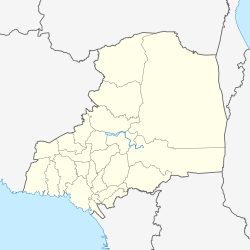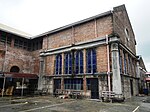San Juan Bautista Church (Calumpit)
| Calumpit Church | |
|---|---|
| Diocesan Shrine and Parish of Saint John the Baptist | |
 | |
| 14°54′58″N 120°46′08″E / 14.916077°N 120.768793°E | |
| Location | Poblacion, Calumpit, Bulacan |
| Country | Philippines |
| Denomination | Roman Catholic |
| History | |
| Former name(s) |
|
| Status | Parish Church, Diocesan Shrine |
| Founded | May 3, 1572 |
| Founder(s) |
|
| Dedication | Saint John the Baptist |
| Relics held | John the Baptist |
| Architecture | |
| Functional status | Active |
| Architectural type | Church building |
| Style | Baroque, Insipient Baroque |
| Completed | 1779 |
| Specifications | |
| Number of domes | 1 |
| Number of spires | 1 |
| Materials | Sand, gravel, cement, mortar, steel, brick |
| Administration | |
| District | Western District (Vicariate of Saint James the Apostle) |
| Archdiocese | Manila |
| Diocese | Malolos |
| Parish | Saint John the Baptist Parish |
| Clergy | |
| Archbishop | José Fuerte Advíncula, Jr |
| Bishop(s) | Dennis Cabanada Villarojo |
| Priest in charge | Rev. Fr Ventura P. Galmán |
| Assistant priest(s) |
|
The Diocesan Shrine and Parish of Saint John the Baptist, also known as the San Juan Bautista Parish Church and commonly known as Calumpit Church, is a 17th-century, Roman Catholic, baroque church located in Calumpit, Bulacan, Philippines. The parish church, under the patronage of Saint John the Baptist, belongs to the Diocese of Malolos under the Vicariate of Saint James the Apostle.[1]
History
[edit]
Calumpit is recognized as the first site of the evangelization by the Order of Saint Augustine in northern Luzon. The mission field covered the present-day Bulacan province and some areas of adjacent Pampanga such as the town’s neighbour Apalit, Macabebe, and Candaba; some references cite Calumpit as part of Pampanga or as an Alcaldía of Región la Pampanga in the early years of Spanish rule, together with Betis and Lubao.
Calumpit was established as a prior on May 3, 1572, along with the churches of Lubao and Betis. On March 3, 1575, Fray Gaspar de San Agustín did not provide the town's first vicar. The convento of Calumpit was established with the towns of Candaba and Macabebe annexed to it as its visitas. Its first titular patron is Saint Nicholas of Tolentine, but on December 31, 1576, its convento was referred to as La Casa de San Juan Bautista.
It has been recorded that Fray Martín de Rada with Fray Diego Vivar Ordóñez from Calumpit were the first to proselytise in Bulakan, Malolos, and Hagonoy. On June 11, 1580, Malolos was separated as convento, and Hagonoy on April 22, 1581.
In 1619, Paombong was ceded from its original mother town which annexed in Calumpit, but in 1664 it was reunited with Malolos. Calumpit was by then a vital mission center due to its proximity to river systems that enabled transport for missionaries. Despite its important role in the Christianisation of Bulacan, reports show that its convento was once declared vacant due to a lack of priests.[2]
Architectural history
[edit]Extant references do not identify the priest responsible for constructing the present structures, although it is assumed that both buildings were completed in the mid-17th century.[2] Other references say that Vivar-Ordóñez erected the current church.[3] Father Joaquín Martínez de Zúñiga, the prior from 1794 to 1797, noted that at his time the small convento was made of cut stone and had a tiled roof. The convento was damaged by the merging of two great rivers in the area: the Río de Quingua (now Angat River) and the Río Grande de Pampanga. The belfry was reportedly “low and not well-shaped”. It was said that locals disliked the shape of the tower and urged numerous parish priests to alter it. Finally, Fray Antonio Llanos rebuilt the tower in 1829. The entire church complex was razed by fire in 1899 during the Philippine Revolution.[2]
Architecture
[edit]The church is smaller than those of Hagonoy and Malolos. The façade is an example of how local artisans experimented with various ornamentation to come up with a lavish, seemingly Mannerist style.[4]
The façade is arranged simply, with four rounded columns with Corinthian capitals supporting the pediment, dividing the entire front into three segments. Floral motifs and scrolls abound on the façade and link the round columns before undulating back into the cornice. Reliefs featuring the lives of saints can be found of the lowest tier of the façade. The flamboyance of the trefoil arched main doorway is matched by the swaying motion of the original pediment, and the volutes framing a circular window. Besides the main doorway and the central window, the facade is pierced by a pair of rectangular windows framed by ornate reliefs.
To the right-hand of the church is the simple, four-tiered belfry that contrasts the profusely ornamented façade.[2][4] Much renovation has been done to the church, one of which concerns the extension of the façade, transforming the original swaying motion of the pediment into the simple, triangular roofline seen today. In recent years, a new, heavily carved wooden door depicting scenes from the life of Saint John the Baptist was installed in the main doorway.
-
Details of window and pediment with a niche for a statue of Saint John the Baptist
-
Ornate side portal, featuring pink reliefs of the Visitation at the top, and figures of Saint Zachary (vested as a kohen) and Saint Elizabeth to the sides
-
Transept on the epistle side
-
Wooden ceiling, the choir loft, and the clerestory
References
[edit]- ^ "Calumpit, 3003". Bulacan Churches. Retrieved November 19, 2014.
- ^ a b c d Galende, OSA, Pedro (1996). Angels in Stone: Architecture of Augustinian Churches in the Philippines (Second ed.). Manila, Philippines: San Agustin Museum. pp. 124–125. ISBN 9719157100.
- ^ "Churches". Visit My Philippines. Department of Tourism. Retrieved November 19, 2014.
- ^ a b Galende, OSA, Pedro (2007). Philippine Church Facades (First ed.). Manila, Philippines: San Agustin Museum; Vibal Publishing House. ISBN 9789710724338.
External links
[edit] Media related to Saint John the Baptist Church (Calumpit, Bulacan) at Wikimedia Commons
Media related to Saint John the Baptist Church (Calumpit, Bulacan) at Wikimedia Commons- San Juan Bautista Church on Facebook
- Roman Catholic churches in Bulacan
- Baroque church buildings in the Philippines
- 1572 establishments in the Philippines
- Churches in the Roman Catholic Diocese of Malolos
- Jubilee churches in the Philippines
- Catholic churches dedicated to John the Baptist
- Churches dedicated to John the Baptist in the Philippines












